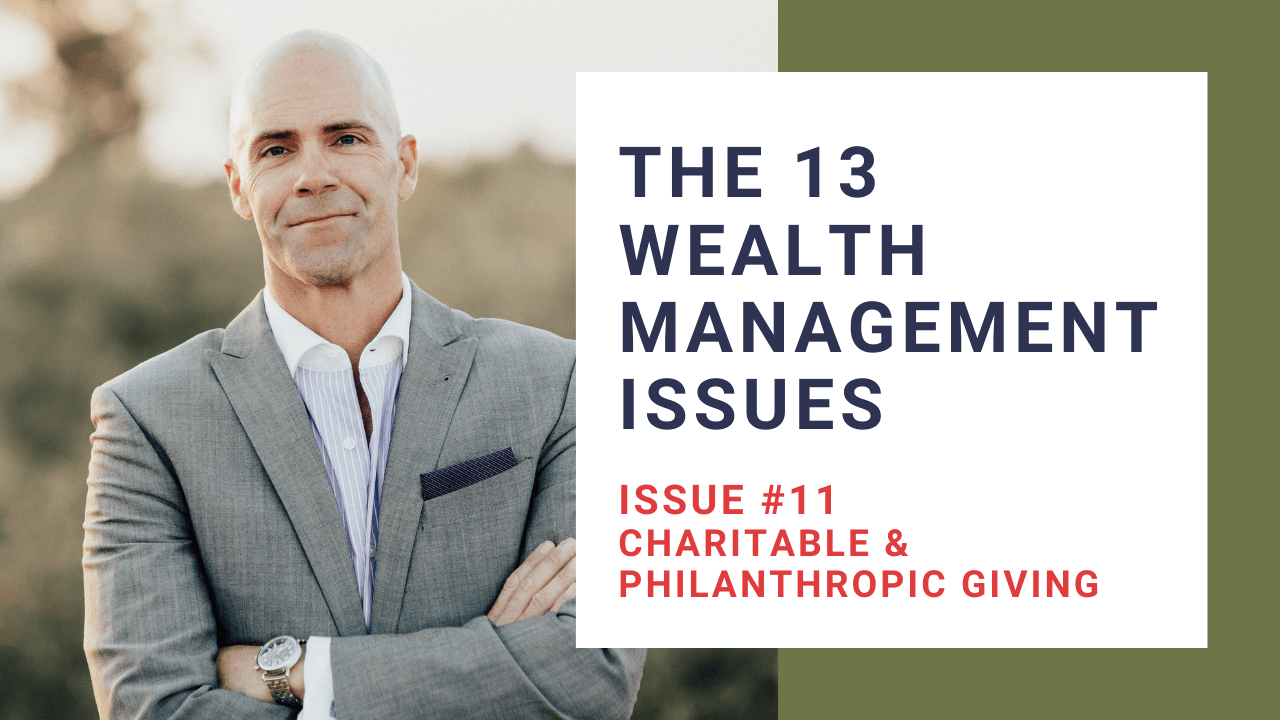
13 Wealth Management Issue #11: Charitable & Philanthropic Giving
As one can imagine, charitable giving is of great importance to many people for a variety of reasons. Some folks are focused on tax efficiency and others are concerned with control issues. In some cases, people want to leave a legacy and have solidly altruistic objectives in mind. More recently, families with multiple generations are seeking to be more inclusive within the family about charitable causes and how the family makes donations in general. Whatever the reasons, diligent planning is critical to optimizing outcomes. These outcomes can often be summarized in one sentence: Maximize clients’ usable dollars while minimizing the tax burden.
Charitable & Philanthropic Giving
Number 11 out of 13 in our Wealth Management Issues Series
One of the first things to consider regarding planned giving is the difference between Charitably Inclined and Philanthropically Motivated. The difference lies in the focus and motivations. Being charitably inclined results in support to many different causes whereas philanthropically motivated involves a narrow focus, for example, a particular university or church or cause. In either case, it’s important to recognize the motivations present while also incorporating potential family dynamics and other financial goals.
Included with this discussion is clearly articulating the three greatest risks when considering charitable & philanthropic giving.
- Not Understanding All The Alternatives: Often folks think someone else has it covered. It’s important to be proficient with current tax law, have knowledge surrounding trusts/family foundations (FF), as well as comfort with Donor Advised Fund (DAF) along with other options. There are ways you can donate your capital or appreciating stock and make a difference, but there other options as well; including using your family’s intellectual and social influence to raise awareness.
- Experiencing a Loss of Influence/Control: Outright gifts result in NO control. Consider FF & DAF to maintain influence.
- Paying Too Much In Taxes: Pretty straightforward, thematically, however, there are enumerable strategies to consider based on objectives. Taxes should never surprise you and your advisor should be able to explain how charitable gifts can be structured for both tax efficiency and maximum control.
Now that the three greatest risks have been covered, let’s move to the three primary modalities for Planned Giving: Direct Transfers, Indirect Transfers and Split Interest Transfers. For purposes of this installment, the topics will be kept VERY lean. There is an incredible amount of detail that needs to be reviewed with your advisors on a collaborative basis.
- Direct Transfers: Donor -> Recipient. Cash/Check. Likely not the most effective from a tax perspective or when considering control. Thus, perhaps evaluating #2 is sensible.
- Indirect Transfers: Donor Advised Funds. Pooled Fund. Family Foundation. Maintain control and potentially significant tax reduction. What if the organization or institution to which your philanthropic motivations changed values? With Direct Transfers there is no recourse. With Indirect transfers, you simply change the direction of the donations.
- Split Transfers: Split interest gifts whereby the value is split between the charity and another entity, beneficiary, etc. There are THREE types of Split Transfers. Again, due to space, the suggestion is to consult your advisors for greater detail.
The first option is a Charitable Remainder Trust (CRT) with two sub-categories including Charitable Remainder Annuity Trust (CRAT) and Charitable Remainder Unit Trust (CRUT). In summary, a certain amount is donated into the CRT. The beneficiary or donor receives payments from the trust until the trust terminates whereupon the proceeds transfer to the philanthropic organization. Taxes are reduced significantly if structured properly.
The second option is a Pooled Income Fund which works for benefit of universities. Much like the CRT strategy, the donor, donor’s spouse, or beneficiary receives an income stream on a pro-rata basis with residual assets transferring to the university upon termination.
The final option is a Charitable Lead Trust (CLT). The CLT works in the inverse to the CRT, whereby the charity receives an income stream for a set period of time and the remaining balance transfers to a designated beneficiary. CLTs have an entirely different tax element associated with them and should be coordinated with specialists.
All of this said, there are ways that you can be charitable, philanthropic, and bring your second and/or third-generation into the financial decisions of your family. Consider that the benefits of charitable and philanthropic giving outlined above all center around the use of financial capital. Financial capital is one of four common types of capital that individuals and families can use to bring about change in their community or on a wider stage with charitable & philanthropic giving. Besides financial capital, there exists intellectual capital, social capital, and human capital.
You may find yourself in a situation where you want to give to certain causes or organizations more than you can or that is strategically financially sound. In these cases, you can leverage these other types of capital to pursue favorable results.
Consider that you may have a goal to donate $1 million dollars to fight heart disease due to the passing of a loved one caused by that disease. Yet financially, you may only be able to donate $300,000 and still pursue your other financial goals. In this example, you might consider hosting a fundraiser or other type of event to raise awareness. Here you are using your intellectual capital and social capital, or your personal or family’s influence, to draw more affluent people to the cause or event. This can have the same effect as you donating $1 million dollars. In fact, if your family were to harness all of its human, intellectual, and social capital for a few years in a row hosting an event or fundraiser, you may be able to exceed your goal and create broader awareness.
You should feel comfortable discussing these types of charitable and philanthropic goals with your advisor. Your advisor can likely speak with your entire family about the causes that are important to them and then cover the ways that your financial, human, intellectual, and social capital can be leveraged to pursue their social goals. Giving is an important financial strategy. You can benefit import causes, reap incredible tax benefits, and potentially get closer with your 2nd and 3rd generations in the family by leveraging all of your family’s capital, not just your financial capital to pursue your charitable or philanthropic goals.
When considering these issues, it’s important to ask yourself, how do any of these affect you, your family, and your goals? The following installments will cover each of these Wealth Management Issues in greater detail. Our hope is this series of chapters will provide not only an educational forum but also promote thought, leading to action…in a holistic manner, of course. Learn about our other 13 Wealth Management Issues here.
Watch our Whiskey & Wealth Wednesday video of this article:
If you would like to learn more about this subject please contact us and we’ll be happy to help.
Charitable Remainder Trust: Such trusts are used to develop a vehicle for donations to a favorite charity, which also allows for the reduction of income taxes through a charitable deduction and favorable tax treatment at the date of the gift by non-recognition of built-in capital gains.
The use of trusts involves a complex web of tax rules and regulations. You should consider the counsel of an experienced estate planning professional before implementing such strategies.
For a comprehensive review of your personal situation, always consult your legal advisor. Neither Cetera Advisors LLC, nor any of its representatives may give legal advice.
By Anthony C. Williams, CWS, ChFC, MRFC, CLU | Investment Advisor Representative | President & Founding Partner of Mosaic Financial Associates & Orthopaedist Advisory Group | Securities and advisory services offered through Cetera Advisors LLC, Member FINRA/SIPC, a broker/dealer and a Registered Investment Advisor. Cetera is under separate ownership from any other named entity.







